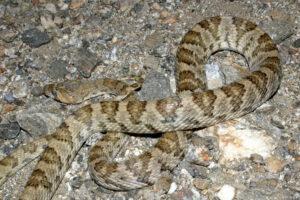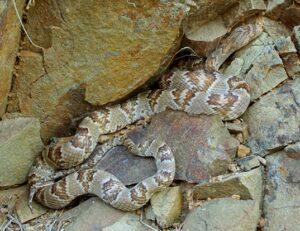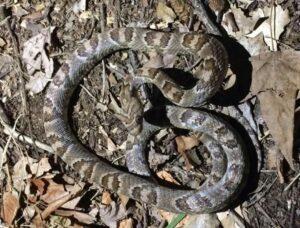
The western lyre snake is a moderately-sized, secretive, semi-arboreal, rock-dwelling colubrid native to Mexico. It gets its name from the v-shaped lyre-like mark on its head.
Scientific Classifications
- Suborder:Serpentes
- Family:Colubridae
- Genus:Trimorphodon
- Species:T. biscutatus
Conservation Status
Description
Size
The adults are approximately 3.3 ft (1m) in size. ,
Color and Appearance
These snakes are usually tan, gray, or brown in color, with dark brown blotches running down their backs. Their bellies are yellow or creamy-white with scattered brown spots. Their big eyes have vertical pupils, and their scales are smooth. The head looks triangular as it is much broader than the narrow neck.
Are They Dangerous to Humans
It is easily alarmed and raises its body above the ground, shakes its tail, hisses, strikes, and even bites the attacker if he doesn’t leave it alone. The mild venom of the rear-fanged western lyre snake does not harm humans, but the chewing action of its bite may cause local swelling, itching, redness, and numbness.
Western Lyre Snakes at a Glance
Distribution
The northern part of its range covers southwestern Utah and southeastern Nevada. It continues south through western Mexico up to Costa Rica.
Habitat
It mainly lives in the rocky canyons and arroyos of mountains and hills from sea level to 7400 ft.
The nocturnal snake spends most of its time hiding in rock crevices and other areas that are difficult for its predators to access.
The snake may be threatened by expanding human populations and related deforestation in parts of its range.
Lifespan
The colubrid has an average lifespan of 12 years.
Predators
Predatory birds (roadrunners and possibly owls), kingsnakes and other ophiophagous (snake-eating) snakes, and predatory mammals eat the western lyre snake.
Diet
The western lyre snake eats lizards, frogs, small rodents, and bats.
The snake grasps the prey with its mouth and chews on it to inject its venom into its body. Envenomation is done with a pair of venom glands and grooved teeth at the back of its mouth. Its hemolytic venom attacks the prey’s red blood cells, reducing their ability to carry oxygen to the tissues. However, it may use constriction to subdue its prey as the hemorrhagic venom is not quite effective on birds and mammals.
Reproduction
Oviparous (lays eggs that hatch outside the body)
The snake lays as many as 20 eggs in summer.
Source
calphotos.berkeley.edu, worldlifeexpectancy.com, i.pinimg.com







